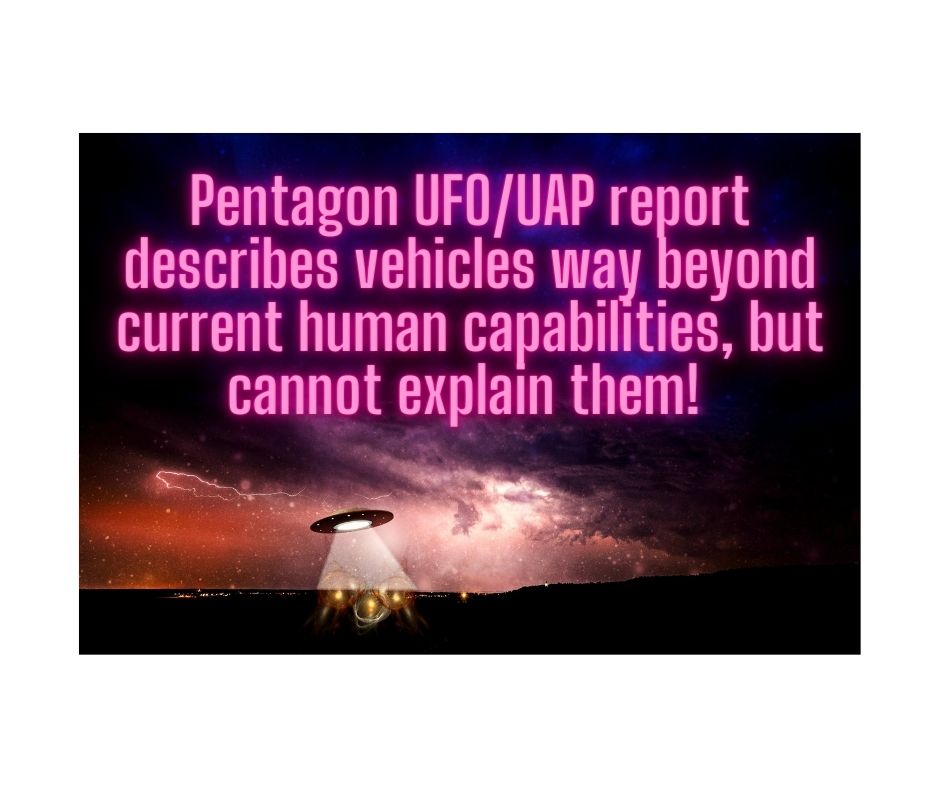; Date: Fri Jun 25 2021
Tags: Unidentified Flying Objects »»»» Unidentified Aerial Phenomena »»»»
Today, the US Defense Department delivered to the US Senate a long-awaited report on what's called Unidentified Aerial Phenomena (UAP), or what the rest of us call Unidentified Flying Objects (UFO). The report does not definitively explain the phenomena, disappointing those who wanted this to be a major Disclosure event. Despite that, the report is a major step forward because it is the first admission by the Defense Department that the UFO/UAP story has credibility.

According to the report, the Preliminary Assessment: Unidentified Aerial Phenomena, US Military personnel had at least 144 encounters with unexplainable aerial phenomena (UFO's) between 2004 to 2021. The majority of those encounters were recorded by multiple instruments, and witnessed by multiple highly trained military pilots, operating some of the best fighter jets in the world, containing some of the best sensor systems for detecting and tracking other aircraft, making for highly credible reporting. Of special interest are the extreme flight capability exhibited by some of the vehicles, that are hundreds of years beyond modern human technology.
But, the report carefully spelled out the lack of data from which to draw conclusions. As expected (Leak: Defense Dept report on UAP/UFO phenomena will say no proof of alien contact), the report is inconclusive. There are many possible explanations, and the number of recorded incidents don't give enough data with which to have certainty. Why isn't there enough incident data to draw conclusions? The Assessment report describes these limitations:
- The Defense Department's primary mission defending the territorial integrity of the United States, meaning they are primarily concerned with terrestrial threats from countries like Russia or China. The DoD's mission certainly does not include serving the whims of UFO fanatics.
- The programs to collect UFO/UAP data are extremely underfunded.
- There is an institutional stigma against reporting UFO incidents. That stigma is an extension of the society-wide derision of anything related to UFO's.
Despite those limitations, they have managed to gather preliminary data proving the existence of SOMETHING. There are vehicles exhibiting capabilities well beyond current human technology, that are regularly interacting with US Military aircraft and vessels.
- Most of the UAP reported probably do represent physical objects given that a majority of UAP were registered across multiple sensors, to include radar, infrared, electro-optical, weapon seekers, and visual observation.
- In a limited number of incidents, UAP reportedly appeared to exhibit unusual flight characteristics.
Those statements are from the official report. What it clearly says is the phenomenon is very real, and the some of the craft fly in ways that current human technology cannot produce. I've seen interviews with some witnesses (fighter pilots involved with the incidents) claiming that the technology in these UAP's is anywhere from 50 to 1000 years ahead of current human capabilities. But the Defense Department does not say anything like that. Instead, the report talks about unusual flight characteristics, and leans on the old patterns of denial like the possibility of "natural atmospheric phenomena".
The stereotype for decades is after every UFO encounter, a Defense Department guy comes around talking about weather balloons or fog banks.
This is not the grand Disclosure event some UFO fanatics want.
Instead of clear pictures from hundreds of encounters that definitively show visitors from all over the galaxy, the report tantalizes us with brief summaries of a modestly sized dataset contained in a classified report us normal people are not allowed to see.
Taken at face value, it would be difficult for the Defense Department to definitively say anything. The existing program has approximately $0 funding, making it impossible to do much to begin with. Then, like so much at the Defense Department, there is the issue of not revealing intelligence gathering methods or techniques to "adversary" countries (China or Russia). Finally, as the report discusses, there is the widespread derision against anything smelling like UFO's.
That stigma against UFO's needs to be put behind us. The Defense Department has come out of its shell and admitted to the phenomena. It can't explain what's happening, but something clearly is happening, and more importantly it is frequently interacting with the military.
Some long-standing UFO proponents - such as Dr. Stephen Greer of the Disclosure Project - claim the Assessment report is a grand coverup even bigger than all previous US Defense Department UFO coverups. According to Greer, the Disclosure Project has eyewitness reports from dozens of former high ranking folks who have seen inside information. Taking those reports at face value, many governments (not just the USA) know quite a bit about UFO's.
In other words, The Disclosure Project contends that today's Defense Department report is a sham.
We must also ponder why the Dept of Defense hasn't taken this issue seriously before? Reportedly US Military forces are routinely encountering vehicles of unknown advanced capability, isn't that a National Security concern? But the Defense Department can't bother to study the issue because it's UFO's and UFO's aren't real?
That doesn't add up, does it? But do we have clear understanding of the actual extent of DoD's knowledge? No.
The US Defense Department report on Unidentified Aerial Phenomena
The report was produced by the Unidentified Aerial Phenomena Task Force (UAPTF), and only considers reports between 2004 and 2021. It talks repeatedly about how reporting lacked sufficient specificity, and that there is now a tailored reporting process to collect UAP data. The new reporting system categorizes report analysis into five buckets:
- Airborne Clutter: These are objects like birds, balloons, recreational unmanned air vehicles ("drones"), flying plastic bags, and other "debris" that can clutter up radar systems.
- Natural Atmospheric Phenomena: These are events like ice crystals, moisture, or temperature fluctuations, that could be misread by infrared or radar systems.
- USG or Industry Developmental Programs: Some sightings could be top-secret research vehicles developed by US Government or US Industry. These would be vehicles developed using human technology, but which cannot be confirmed or denied by the Defense Department because of top secret classification.
- Foreign Adversary Systems: Just as the US Government might have top-secret highly advanced vehicles, so might other governments. Some of the sightings might be from China or Russia, in other words.
- Other: Here's where we get to UFO's, right? Not exactly. This is a catch-all category for anything which could not be identified into one of the other buckets. Yes, that includes extraterrestrials, but could be any many other possibilities.
Because this is the US Defense Department, the primary mission is protecting the USA from threats from foreign adversary governments. In other words, the primary goal is determining whether there is a national security threat from Russia or China. Or, as the report says:
Potential National Security Challenges We currently lack data to indicate any UAP are part of a foreign collection program or indicative of a major technological advancement by a potential adversary. We continue to monitor for evidence of such programs given the counter intelligence challenge they would pose, particularly as some UAP have been detected near military facilities or by aircraft carrying the USG’s most advanced sensor systems.
Limited reporting, unable to draw conclusions
There is a classified report, which contains the actual dataset, which we cannot access because it's all classified. Of the 144 incidents the majority are from the US Navy. But, this could be due to reporting bias because of limited information gathering in the other military services. No standardized reporting process was created until 2019, by the US Navy, which the US Air Force adopted in November 2020.
Of the 144 reports, 80 involve multiple sensors. That's a small number of reports, especially if you consider that a non-government group in Canada collected over 1200 reports in 2020 alone. But, what's truly interesting is that a large percentage are high quality reports - the phrase "multiple sensors" meaning incidents which do not rely on one sketchy measurement from one possibly malfunctioning instrument. Instead, "multiple sensors" means multiple detection systems on multiple aircraft and on nearby naval ships all tracked the same objects using multiple cameras (infrared and visual), radar systems, and human observers.
Further, the personnel involved are highly trained at the task of identifying and tracking adversarial aircraft. They have available some of the best sensor systems in the world. Taken together these are high quality reports that we would be foolish to ignore.
One issue limiting the number of reports is the stigma of making UFO reports that causes pilots to be wary of making such a report.
- Narratives from aviators in the operational community and analysts from the military and IC describe disparagement associated with observing UAP, reporting it, or attempting to discuss it with colleagues. Although the effects of these stigmas have lessened as senior members of the scientific, policy, military, and intelligence communities engage on the topic seriously in public, reputational risk may keep many observers silent, complicating scientific pursuit of the topic.
Unexplained oddball flight characteristics of UAP's
Another detail is that 18 incidents involve observers (who) reported unusual UAP movement patterns or flight characteristics. It goes on to explain it this way:
Some UAP appeared to remain stationary in winds aloft, move against the wind, maneuver abruptly, or move at considerable speed, without discernible means of propulsion. In a small number of cases, military aircraft systems processed radio frequency (RF) energy associated with UAP sightings.
The UAPTF holds a small amount of data that appear to show UAP demonstrating acceleration or a degree of signature management.
The interviews given by US Navy pilots discuss this in greater detail. For example, frequently the contact might start with a vehicle at 18,000 feet altitude, that suddenly moves to 50 feet altitude in a few seconds. There's no acceleration to speed, then deceleration from speed, and instead the craft simply starts moving at a different velocity, suddenly shifts direction, and so forth, without making the kind of maneuvers current human aircraft do. For example a direction change does not mean the UAP "banks" to change direction, but it simply changes direction.
The report tantalizes us with a confirmation, but the details are in the classified report that we cannot see.
Requesting increased funding to improve data collection and get a better understanding
This report is part of the yearly budget request for the Director of National Intelligence.
It makes a clear case that SOMETHING, real physical vehicles, is regularly interacting with military forces. These vehicles have capabilities way beyond what our forces can counter.
This isn't a new-agey Contact scenario, in the mind of the Defense Department. Are the intentions of these contacts known? What are the capabilities? Who is occupying these vehicles? Can we reverse engineer how those vehicles work?
There is a clear need for further study. The report talks of plans to implement machine learning algorithms to better study the data.
That would be a start of something that a shoestring budget could implement. But it's not the sort of project which produces the long-desired Disclosure event the UFO fanatics desire. Nor does it help us fulfill our Science Fiction Fantasies of how space flight works.
There is a real phenomena here to understand. And keeping that study trapped within the Defense Department may be a mistake.
Links
Source:
-
OFFICE OF THE DIRECTOR OF NATIONAL INTELLIGENCE - Preliminary Assessment: Unidentified Aerial Phenomena - 25 June 2021
-
S. Rept. 116-233 - INTELLIGENCE AUTHORIZATION ACT FOR FISCAL YEAR 2021 -- This bill contains the requirement that the DoD produce this report











